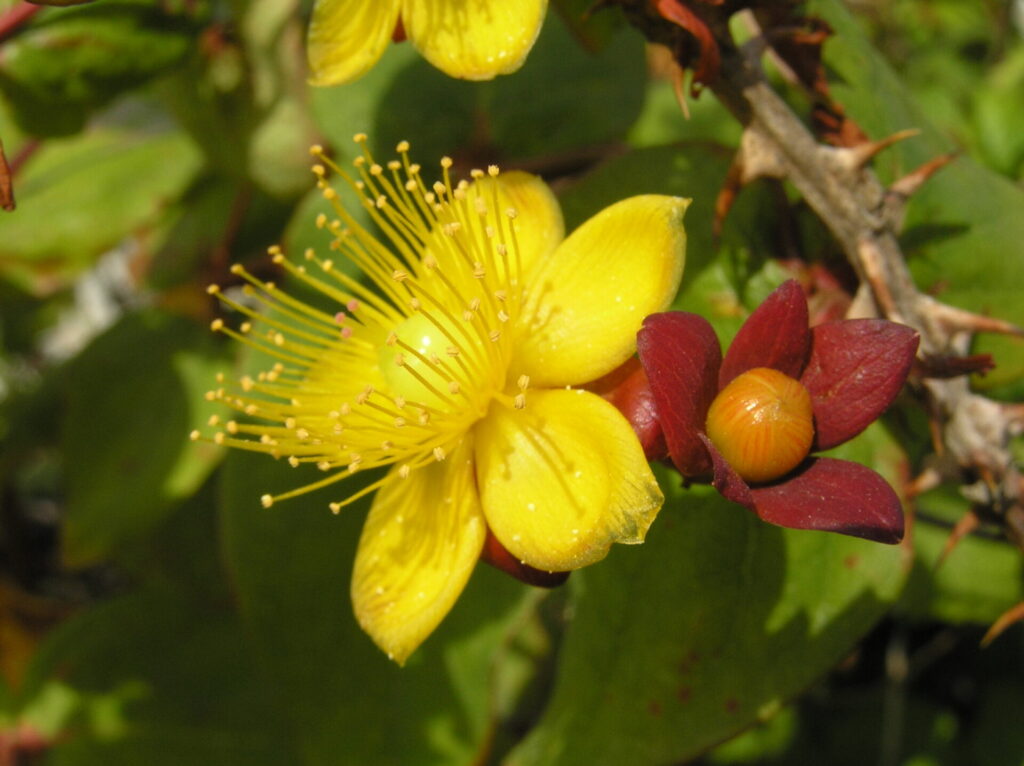
The family Hypericaceae has only one genus: Hypericum and the most useful plant in this genus is the St John’s Wort or Hypericum perforatum.
But there are other species with medicinal uses as you can read on the next page and many shrubby Hypericums in particular make good garden shrubs with simple yellow flowers and often attractive fruits. These are often arrived on the B.I. as a garden shrub and then spread succesfully in the wild.
The herbaceous Hypericums are pretty wildflowers too, worth growing in an ornamental border and also as I found out from this blog that their pollen is good food for bees:
“I love Hypericum shrubs. I adore the cheerful yellow flowers and the berries afterwards (the seeds inside the berries are eaten by some bird species).
It can be quite comical to watch bees, especially fat bumble bee queens and large workers, landing, and almost bouncing on the stamens, which on some varieties are rather long – these are specimens I advise selecting for a bee garden.
Most often, I tend to notice honey bees and bumble bees on the flowers, although some solitary species may also be observed. Other pollinators like Hypericum too; especially hover flies.“
The Plant Atlas 2020 online describes 19 species of Hypericum + 1 hybrid and 2 subspecies of Hypericum maculatum. You’ll find all the species on the next page and the descriptions of the more common species.
Information is used from the Plant Atlas Online mainly on the habitat of the plant and the link on the scientific name gets you to this website page. Pictures of the plant can often be found in the Gallery of the website. The link on the common name gets you to Wikipedia or any other often UK website. Pictures by Mike Poulton or Wikipedia Commons. A special thank you to https://cambridgewildflowers.blogspot.com/ where you can find good descriptions and pictures of the various Hypericums.
Blue background for the habitat and wildlife notes. Green background for various uses and pink background for medicinal use. FBBC added behind name in Contents if plant is mentioned or found in the Birmingham and Black Country Flora.
In Stace the genus Hypericum is subdivided into 9 sections; each section having things in common, mostly in the way the plant looks.
Contents:
Section 1 Ascyreia:
Hypericum calycinum or Rose of Sharon FBBC
H. pseudohenryi or Irish Tutsan FBBC
H. forrestii or Forrest’s Tutsan
H. x hidcoteense or Hidcote St John’s Wort FBBC
Section 2 Androsaemum:
H. androsaemum or Tutsan FBBC
H. x inodorum or Tall Tutsan FBBC
H. hircinum or Stinking Tutsan FBBC
Section 3 Inodora:
H. xylosteifolium or Turkish Tutsan
Section 4 Hypericum:
H. perforatum or Perforate St John’s Wort FBBC
H. maculatum or Imperforate St John’s Wort and FBBC
- H. maculatum ssp. maculatum
- H. maculatum ssp. obtusiusculum
